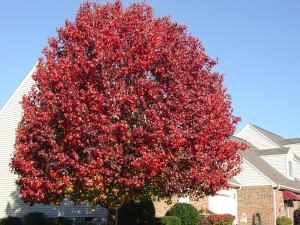Callery pear (Pyrus calleryana) has been declining in planting popularity. But its scarlet red leaf color is both sensational and reliable every autumn in the Southern Appalachian region (USDA zones 6 and 7). Most people identify the tree by its cultivar name, e.g. ‘Bradford’, Aristocrat®, ‘Cleveland Select’, ‘Redspire’ pear. There are many other cultivars.
Callery pears are tough reliable medium sized trees which mature to heights from 30-50 feet. Mature tree widths vary from one cultivar to the other. Callery pears transplant and grow well in any soil type as long as it is well drained. Callery pears are excellent choices for planting in new treeless neighborhoods, the ground mostly consisting of marginal subsoil. Just add the proper amount of fertilizer, such as 10-10-10 or equivalent, and irrigate during the first two summers.
Cultivars vary in their susceptibility to fireblight, a serious bacterial disease. Bradford and Cleveland Select are very resistant and Redspire and Aristocrat are very susceptible. When fire blight strikes, numerous dieback shoots must be pruned off, gathered, and hauled away from the property. Do not attempt to compost the diseased shoots.
The “cookie-cutter” upright branching form is their Achilees’ heel. It is subject to limb breakage, beginning in 12-14 years after planting. Bradford is most susceptible and Aristocrat and Cleveland Select less so.
Autumn foliage colors may be waning, but Callery pears will be blooming again in early spring.


 Posted in
Posted in 
